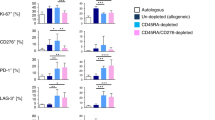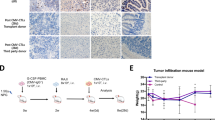Abstract
In previous studies, we observed that a high proportion of donor-derived CD4+ T cells expressing the chemokine receptor 7 (CCR7) was a major determinant of acute GVHD, without interfering with the incidence of other post-transplant outcomes, especially relapse and nonrelapse mortality rates. Here, we investigated in vitro the impact of partially selective CD4+/CCR7+ T lymphocytes on acquired anti-infective immune response in 10 donors who underwent G-CSF-primed PBSC collection. Similar quantitative and functional proliferative reactions were observed in lymphocyte cultures in the presence of adenovirus and pp65 Ags with unmanipulated and partially depleted donor samples. No responses were observed in the presence of human T-cell lymphotropic virus type 1 used as a negative control. These results complete the proof of concept needed to build a clinical trial investigating partially selective CD4+/CCR7+ T cell-depleted allo-SCT.
This is a preview of subscription content, access via your institution
Access options
Subscribe to this journal
Receive 12 print issues and online access
$259.00 per year
only $21.58 per issue
Buy this article
- Purchase on Springer Link
- Instant access to full article PDF
Prices may be subject to local taxes which are calculated during checkout



Similar content being viewed by others
References
Yakoub-Agha I, de La Salmoniere P, Ribaud P, Sutton L, Wattel E, Kuentz M et al. Allogeneic bone marrow transplantation for therapy-related myelodysplastic syndrome and acute myeloid leukemia: a long-term study of 70 patients-report of the French society of bone marrow transplantation. J Clin Oncol 2000; 18: 963–971.
Yakoub-Agha I, Fawaz A, Folliot O, Guillerm G, Quesnel B, Fenaux P et al. Allogeneic bone marrow transplantation in patients with follicular lymphoma: a single center study. Bone Marrow Transplant 2002; 30: 229–234.
Horowitz MM, Gale RP, Sondel PM, Goldman JM, Kersey J, Kolb HJ et al. Graft-versus-leukemia reactions after bone marrow transplantation. Blood 1990; 75: 555–562.
Appelbaum FR . Graft versus leukemia (GVL) in the therapy of acute lymphoblastic leukemia (ALL). Leukemia 1997; 11 (Suppl 4): S15–S17.
Johnson BD, Becker EE, Truitt RL . Graft-vs.-host and graft-vs.-leukemia reactions after delayed infusions of donor T-subsets. Biol Blood Marrow Transplant 1999; 5: 123–132.
Ruggeri L, Capanni M, Tosti A, Urbani E, Posati S, Aversa F et al. Innate immunity against hematological malignancies. Cytotherapy 2002; 4: 343–346.
Talmadge JE . Hematopoietic stem cell graft manipulation as a mechanism of immunotherapy. Int Immunopharmacol 2003; 3: 1121–1143.
Peters C, Matthes-Martin S, Fritsch G, Holter W, Lion T, Witt V et al. Transplantation of highly purified peripheral blood CD34+ cells from HLA-mismatched parental donors in 14 children: evaluation of early monitoring of engraftment. Leukemia 1999; 13: 2070–2078.
Gajewski J, Gjertson D, Cecka M, Tonai R, Przepiorka D, Hunt L et al. The impact of T-cell depletion on the effects of HLA DR beta 1 and DQ beta allele matching in HLA serologically identical unrelated donor bone marrow transplantation. Biol Blood Marrow Transplant 1997; 3: 76–82.
Andre-Schmutz I, Le Deist F, Hacein-Bey S, Hamel Y, Vitetta E, Schindler J et al. Donor T lymphocyte infusion following ex vivo depletion of donor anti-host reactivity by a specific anti-interleukin-2 receptor P55 chain immunotoxin. Transplant Proc 2002; 34: 2927–2928.
Tiberghien P, Reynolds CW, Keller J, Spence S, Deschaseaux M, Certoux JM et al. Ganciclovir treatment of herpes simplex thymidine kinase-transduced primary T lymphocytes: an approach for specific in vivo donor T-cell depletion after bone marrow transplantation? Blood 1994; 84: 1333–1341.
Barrett AJ, Rezvani K, Solomon S, Dickinson AM, Wang XN, Stark G et al. New developments in allotransplant immunology. Hematology (Am Soc Hematol Educ Program) 2003, 350–371.
Tabilio A, Falzetti F, Zei T, De Ioanni M, Bonifacio E, Battelli F et al. Graft engineering for allogeneic haploidentical stem cell transplantation. Blood Cells Mol Dis 2004; 33: 274–280.
Mohty M, Labopin M, Balere ML, Socie G, Milpied N, Tabrizi R et al. Antithymocyte globulins and chronic graft-vs-host disease after myeloablative allogeneic stem cell transplantation from HLA-matched unrelated donors: a report from the Societe Francaise de Greffe de Moelle et de Therapie Cellulaire. Leukemia 2010; 24: 1867–1874.
Bertz H, Spyridonidis A, Wasch R, Grullich C, Egger M, Finke J . A novel GVHD-prophylaxis with low-dose alemtuzumab in allogeneic sibling or unrelated donor hematopoetic cell transplantation: the feasibility of deescalation. Biol Blood Marrow Transplant 2009; 15: 1563–1570.
Yakoub-Agha I, Saule P, Depil S, Micol JB, Grutzmacher C, Boulanger-Villard F et al. A high proportion of donor CD4+ T cells expressing the lymph node-homing chemokine receptor CCR7 increases incidence and severity of acute graft-versus-host disease in patients undergoing allogeneic stem cell transplantation for hematological malignancy. Leukemia 2006; 20: 1557–1565.
Anderson BE, McNiff J, Yan J, Doyle H, Mamula M, Shlomchik MJ et al. Memory CD4+ T cells do not induce graft-versus-host disease. J Clin Invest 2003; 112: 101–108.
Chen BJ, Cui X, Sempowski GD, Liu C, Chao NJ . Transfer of allogeneic CD62L- memory T cells without graft-versus-host disease. Blood 2004; 103: 1534–1541.
Coghill JM, Carlson MJ, Panoskaltsis-Mortari A, West ML, Burgents JE, Blazar BR et al. Separation of graft-versus-host disease from graft-versus-leukemia responses by targeting CC-chemokine receptor 7 on donor T cells. Blood 2010; 115: 4914–4922.
Foster AE, Marangolo M, Sartor MM, Alexander SI, Hu M, Bradstock KF et al. Human CD62L- memory T cells are less responsive to alloantigen stimulation than CD62L+ naive T cells: potential for adoptive immunotherapy and allodepletion. Blood 2004; 104: 2403–2409.
Xystrakis E, Bernard I, Dejean AS, Alsaati T, Druet P, Saoudi A . Alloreactive CD4 T lymphocytes responsible for acute and chronic graft-versus-host disease are contained within the CD45RC high but not the CD45RClow subset. Eur J Immunol 2004; 34: 408–417.
Ahmadzadeh M, Hussain SF, Farber DL . Heterogeneity of the memory CD4 T cell response: persisting effectors and resting memory T cells. J Immunol 2001; 166: 926–935.
Cooke KR, Hill GR, Gerbitz A, Kobzik L, Martin TR, Crawford JM et al. Tumor necrosis factor-alpha neutralization reduces lung injury after experimental allogeneic bone marrow transplantation. Transplantation 2000; 70: 272–279.
Wysocki CA, Panoskaltsis-Mortari A, Blazar BR, Serody JS . Leukocyte migration and graft-versus-host disease. Blood 2005; 105: 4191–4199.
Hopken UE, Droese J, Li JP, Joergensen J, Breitfeld D, Zerwes HG et al. The chemokine receptor CCR7 controls lymph node-dependent cytotoxic T cell priming in alloimmune responses. Eur J Immunol 2004; 34: 461–470.
Chang YJ, Zhao XY, Huo MR, Huang XJ . Expression of CD62L on donor CD4(+) T cells in allografts: correlation with graft-versus-host disease after unmanipulated allogeneic blood and marrow transplantation. J Clin Immunol 2009; 29: 696–704.
Ermann J, Hoffmann P, Edinger M, Dutt S, Blankenberg FG, Higgins JP et al. Only the CD62L+ subpopulation of CD4+CD25+ regulatory T cells protects from lethal acute GVHD. Blood 2005; 105: 2220–2226.
Winn R, Vedder N, Ramamoorthy C, Sharar S, Harlan J . Endothelial and leukocyte adhesion molecules in inflammation and disease. Blood Coagul Fibrinolysis 1998; 9 (Suppl 2): S17–S23.
Sharar SR, Chapman NN, Flaherty LC, Harlan JM, Tedder TF, Winn RK . L-selectin (CD62L) blockade does not impair peritoneal neutrophil emigration or subcutaneous host defense to bacteria in rabbits. J Immunol 1996; 157: 2555–2563.
van Leeuwen EM, van Buul JD, Remmerswaal EB, Hordijk PL, ten Berge IJ, van Lier RA . Functional re-expression of CCR7 on CMV-specific CD8+ T cells upon antigenic stimulation. Int Immunol 2005; 17: 713–719.
Appay V, Dunbar PR, Callan M, Klenerman P, Gillespie GM, Papagno L et al. Memory CD8+ T cells vary in differentiation phenotype in different persistent virus infections. Nat Med 2002; 8: 379–385.
Romero P, Zippelius A, Kurth I, Pittet MJ, Touvrey C, Iancu EM et al. Four functionally distinct populations of human effector-memory CD8+ T lymphocytes. J Immunol 2007; 178: 4112–4119.
Sourdive DJ, Murali-Krishna K, Altman JD, Zajac AJ, Whitmire JK, Pannetier C et al. Conserved T cell receptor repertoire in primary and memory CD8 T cell responses to an acute viral infection. J Exp Med 1998; 188: 71–82.
Reichstetter S, Standifer NE, Geubtner KA, Liu AW, Agar SL, Kwok WW . Cytotoxic herpes simplex type 2-specific, DQ0602-restricted CD4 T+-cell clones show alloreactivity to DQ0601. Immunology 2006; 117: 350–357.
Zorn E, Wang KS, Hochberg EP, Canning C, Alyea EP, Soiffer RJ et al. Infusion of CD4+ donor lymphocytes induces the expansion of CD8+ donor T cells with cytolytic activity directed against recipient hematopoietic cells. Clin Cancer Res 2002; 8: 2052–2060.
Weinberg A, Zhang L, Hayward AR . Alloreactive cytotoxic CD4+ responses elicited by cytomegalovirus-infected endothelial cells: role of MHC class I antigens. Viral Immunol 2000; 13: 37–47.
Harari A, Rizzardi GP, Ellefsen K, Ciuffreda D, Champagne P, Bart PA et al. Analysis of HIV-1- and CMV-specific memory CD4 T-cell responses during primary and chronic infection. Blood 2002; 100: 1381–1387.
Chen JJ, Huang JC, Shirtliff M, Briscoe E, Ali S, Cesani F et al. CD4 lymphocytes in the blood of HIV(+) individuals migrate rapidly to lymph nodes and bone marrow: support for homing theory of CD4 cell depletion. J Leukoc Biol 2002; 72: 271–278.
Amyes E, Hatton C, Montamat-Sicotte D, Gudgeon N, Rickinson AB, McMichael AJ et al. Characterization of the CD4+ T cell response to Epstein-Barr virus during primary and persistent infection. J Exp Med 2003; 198: 903–911.
Sasson SC, Zaunders JJ, Kelleher AD . The IL-7/IL-7 receptor axis: understanding its central role in T-cell homeostasis and the challenges facing its utilization as a novel therapy. Curr Drug Targets 2006; 7: 1571–1582.
Crooks GM, Weinberg K, Mackall C . Immune reconstitution: from stem cells to lymphocytes. Biol Blood Marrow Transplant 2006; 12 (Suppl 1): 42–46.
Acknowledgements
We thank all the donors who accepted to participate in this research and the members of the association Capucine for their generous support to our clinical and basic research work. This study has been entirely conducted with a donation from the Association Capucine.
Author information
Authors and Affiliations
Corresponding author
Ethics declarations
Competing interests
The authors declare no conflict of interest.
Additional information
Author contributions
BC, JT and ST contributed to analysis and wrote the manuscript; ML designed and supervised the study, analyzed data and wrote the manuscript. IY-A designed and supervised the study, enrolled the donors, analyzed data and wrote the manuscript.
Rights and permissions
About this article
Cite this article
Choufi, B., Trauet, J., Thiant, S. et al. Donor-derived CD4+/CCR7+ T-cell partial selective depletion does not alter acquired anti-infective immunity. Bone Marrow Transplant 49, 611–615 (2014). https://doi.org/10.1038/bmt.2014.6
Received:
Revised:
Accepted:
Published:
Issue Date:
DOI: https://doi.org/10.1038/bmt.2014.6
Keywords
This article is cited by
-
Evaluation of therapeutic targeting of CCR7 in acute graft-versus-host disease
Bone Marrow Transplantation (2020)
-
Donor-derived CD4+/CCR7+ T-cell impact on acute GVHD incidence following haplo-HCT after reduced intensity conditioning and posttransplant cyclophosphamide
Bone Marrow Transplantation (2019)
-
Cytotect®CP as salvage therapy in patients with CMV infection following allogeneic hematopoietic cell transplantation: a multicenter retrospective study
Bone Marrow Transplantation (2018)



